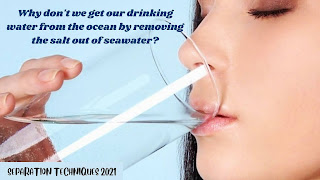How to separate oil from water by using separation techniques?
Two immiscible liquids, oil and water, can be partitioned by using Separating Funnel. The mixture of oil and water forms two separate layers because they are completely irresolvable in each other. Oil forms the upper layer while water forms the lower layer. In separating funnel they are kept for relaxing, when the two layers become balanced by using separating funnel they are filtered one by one. The procedure involves using the mixtures of differing particle density. The mechanism associate taking advantage of the unequal density of the particles in the mixture. Because water is heavy than oil, it can be separated by means of the funnel and left in the funnel with an oil layer.
Method
to separate the mixture:
Once the liquids are taken in the funnel, we can see
the development of two layers. The heavy liquid dig to the bottom and the other
liquid is on the top. A conical flask is placed at the bottom to collect the
heavy liquid. The faucet
Allows you to
handle when and how of the liquid is let through down to the conical flask.
There
are 6 ways to separate oil and water:
1. HOW TO HEAT SEPARATES AN OIL AND WATER ACRYLIC
When separating liquids from each other, heating to
certain temperatures add to separation. When the temperature of an oil and
water acrylic is increased, the thickness of oil is decreased. This lower
thickness allows the gas and water molecules to be more easily released.
Heating oil acrylic also increases density between oil and water.
2. GRAVITY SEPARATION
Gravity separation is the most generally used method
for oil emulsion separation. The elements in the well stream such as oil and
water have different weight.
The density differences allow water to separate by
weight. With enough time in a non-turbulent state, the differing exact weight
will naturally separate.
3. RETENTION TIME
Separation appears over time. When you remove the
acceleration of a fluid, you allow the fluid a convinced amount of time for it
to be separated by weight.
Detention time is the amount of time the fluid stays
in a steady or non-agitated state inside a separator. Longer Detention time
means more separation.
A larger-diameter or taller vessel will increase the
detention time and allow more water to settle out by weight.
4. HOW TURMOIL SEPARATES AN OIL AND WATER EMULSION
A production fluid is turmoil when it hits the
diverter plate at the inlet of a vessel. The immediate impact on the plate
causes a rapid change in direction and velocity which helps break the area
strain of the liquids and start the separation process. There are many types of
basin diverters in separators and choice will be made by the aspect and volume
of the well stream.
Turmoil increases the probability that the liquid
will integrate and settle from the emulsion.
5. COALESCING
During coalescence, water beads come together to form larger drops. Picture driving on a cloudy morning. There's lots of fog in the air, but it doesn't compress into liquid until it hits your windshield.
The same is true when gas hits a solid surface. This
may be a diverter plate when it first arrive the vessel, or a fog eliminator as
it exits.
6. HOW CHEMICAL DEMULSIFIERS SEPARATE AN OIL AND
WATER ACRYLIC
Treating broth with demulsifies aids the separation
process. The chemicals move to the oil and water annexation, weakening the
surface tension and appreciate coalescence. Knowing which chemicals to use and
the correct measure can be complex, but the covet effect will minimize the
amount of heat or detention time required for separation.



Comments
Post a Comment